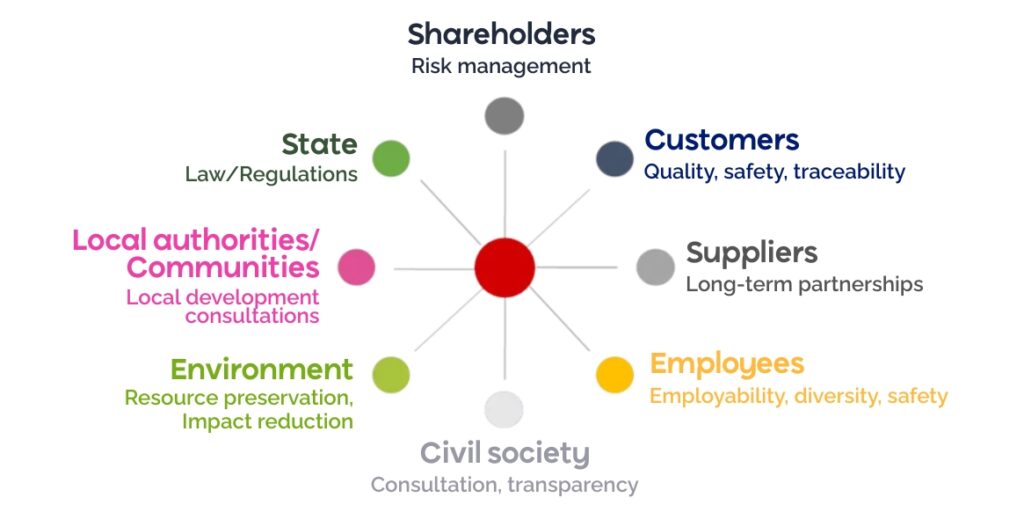

Implementing a CSR approach is a major challenge for organisations facing growing environmental and societal challenges. But how can you get involved in practical terms? How can you define a coherent and effective CSR strategy? How can you implement it and measure its impact?
Follow these 7 steps to contribute to a more sustainable and responsible future.
1. Understanding the challenges of CSR
Before embarking on the implementation of a CSR approach, it is essential to understand its challenges and fundamental principles. Standards such as ISO26000 and the Global Reporting Initiative (GRI) are key tools for understanding your most important challenges.
Next, it is essential to consider the expectations of stakeholders, such as customers, employees, investors and local communities. To do this, start by identifying your organisation's stakeholders and mapping them out by defining their level of interest and influence over the company's decisions.
Here is an overview of the stakeholders:

Finally, prioritise your CSR issues. This analysis will highlight the challenges that are most important to you and your company's stakeholders. This information can be used to develop a materiality matrix that will help you focus your CSR efforts.
If you are subject to the CSRD, your analysis must take two aspects into account. On the one hand, there is your company's impact on its environment and stakeholders. On the other hand, you must consider the risks and opportunities for your company arising from CSR issues. This is known as double materiality.
2. Identifying the company's impacts
Once your company's CSR issues have been clearly identified, it is necessary to quantify their impacts. This step helps to define the priority areas on which the company should focus in order to improve its sustainable performance. This involves both limiting negative impacts and increasing positive impacts.
Focus on the impacts with the greatest value, even if the actions to be implemented are more complex. For example, in terms of carbon impact, employees travelling by car or plane probably have a greater impact than turning off their screens in the evening.
3. Setting ambitious and SMART CSR objectives
Based on the impact analysis, it is important to set specific, measurable, achievable, realistic and time-bound (SMART) CSR objectives. These objectives must be ambitious, achievable and reflect the company's commitment to contributing to sustainable development.
For example, a target of reducing emissions by 3,000 tonnes of CO2 per year, out of a total of 20,000 tonnes, measured across the three scopes of the carbon footprint, is a SMART objective. It clearly indicates the impact of the company's commitment. Conversely, sustainability reports often refer to a commitment to reduce emissions by ‘10%’ without specifying the scopes (or on a limited basis, such as scopes 1&2) or the initial impact. This type of indicator is more a matter of greenwashing than commitment, and tells us nothing about the company’s impact.
Once again, if you are subject to the CSRD, your objectives are among the elements to be included in your reporting. In subsequent years, the achievement of these objectives will be verified as part of the audit, so be careful not to set unrealistic objectives, while being ambitious enough to stand out from your competitors!
4. Developing a concrete action plan for your CSR approach
To achieve your CSR objectives, you need to develop a detailed action plan. This plan must define the specific actions to be implemented, the resources required, responsibilities and deadlines. It is important to ensure that the action plan is consistent with the company's overall strategy and aligned with stakeholder priorities.

5. CSR approach: implementing and monitoring actions
Once the action plan has been defined, it is crucial to implement it effectively. This involves mobilising all of the company's employees and communicating regularly on the progress made. It is also important to monitor key performance indicators (KPIs) to measure the impact of CSR actions and identify areas for improvement.
6. Communicating and reporting
Communication is essential to the success of a CSR approach. It is important to share the company's CSR commitments with all stakeholders, both internally and externally. This can be done through CSR reports, publications on the company's website or participation in CSR-related events.
7. Improving continuously
A CSR approach is a journey, not a destination. It is important to engage in a process of continuous improvement and to demonstrate transparency and accountability to stakeholders.
This is a long-term commitment. It is important to set new objectives and update the action plan in line with the needs and expectations of stakeholders, reviewing the company's CSR approach if necessay.
The article produced in collaboration with Bineta Coulibali, Junior CSR Consultant at Cegos and was originally published on "Le Mag" under the title "Démarche RSE : les 7 étapes pour une mise en place efficace"




